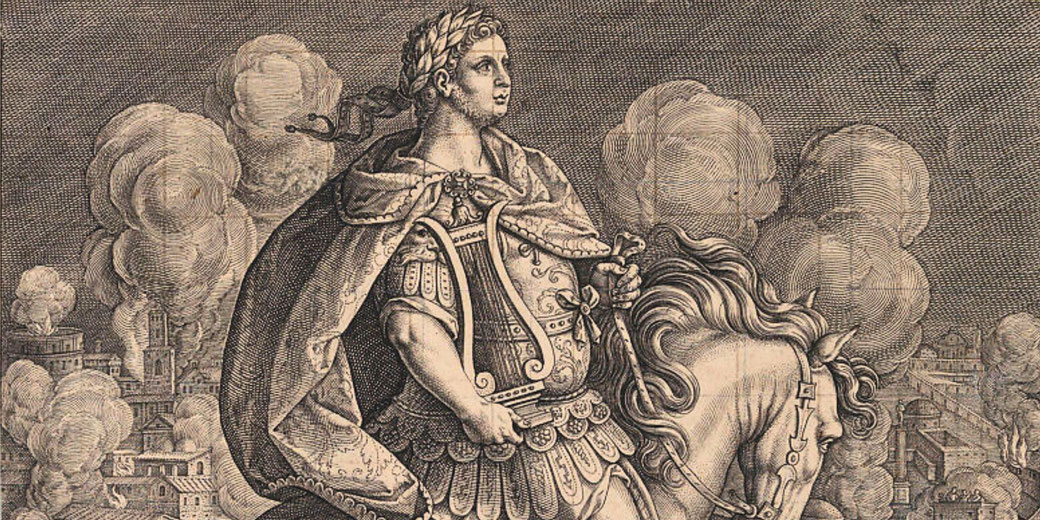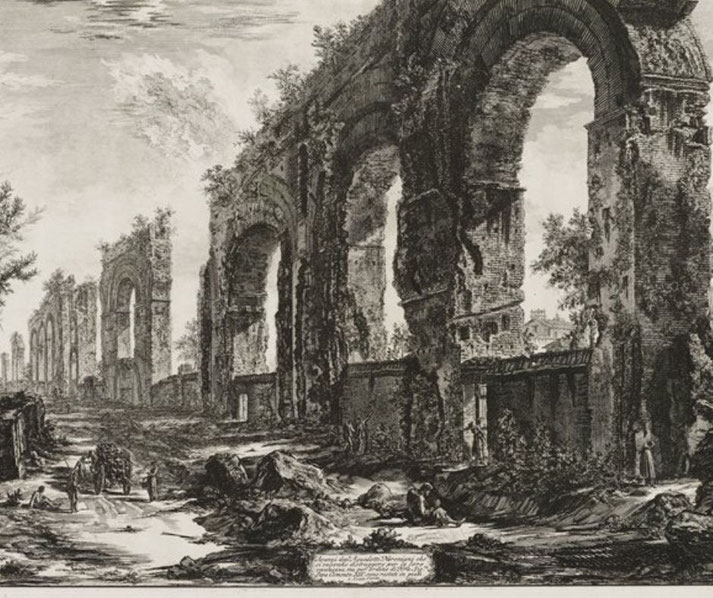The Great Fire of Rome: Did Emperor Nero really watch on as the city burned around him?

On the night of 18 July 64 AD, flames erupted in the crowded merchant quarter of Rome and spread rapidly through timber-framed buildings very quickly.
As the fire tore across the city for more than a week, some observers began to whisper that Emperor Nero had stood aside, had watched the destruction, and had performed songs about Troy.
Over time, this story became a legend, yet the causes of the fire, the actions of Nero, and the scapegoating that followed showed a suspicious chain of events with multiple causes.
A catastrophe waiting to happen...
By the mid-first century AD, Rome had largely grown into a disorderly sprawl of over one million inhabitants.
Large villas and public monuments stood near narrow lanes crammed with insulae, which were multi-storey tenements built from wood and other materials that burned easily.
These dwellings, which were often poorly constructed and overcrowded, leaned across the streets and left little space between buildings.
To explain this danger, Roman engineers and magistrates had already raised concerns about fire hazards in the city’s layout.
Apartments had cooking areas with open flames, and shopfronts below often stored barrels of olive oil, wine, or grain, which increased the risks.
Buckets and basic pumps did not offer much protection, since fires often spread rapidly and caused widespread damage before help could arrive.
At the time, firefighting efforts largely remained poorly organised, since aediles supervised small brigades, but they lacked proper tools and coordinated support.
Since Augustus had established the Vigiles Urbani in 6 AD as a night watch and firefighting corps, their force of around 7,000 men was then tasked with patrolling the city.
However, their equipment and training proved largely not adequate for fires of this size.
With long droughts common in summer, the risk of fire often increased each year.
The city’s rapid growth had far outpaced its safety infrastructure, and no one then had the authority or political will to impose major reforms.
What caused the Great Fire of Rome?
According to Tacitus, the fire began in shops near the Circus Maximus during the night.
Wind pushed by the surrounding hills pushed the flames into residential areas, where buildings collapsed and sparked new blazes.
Within hours, entire neighbourhoods had were destroyed and covered by smoke and ash.
No single cause was conclusively proven. Some ancient sources claimed arson, while others described chaos and looting that prevented effective firefighting.
As the disaster worsened, rumours soon spread that imperial agents had started the blaze.
Cassius Dio and Suetonius repeated those claims, but neither cited direct witnesses or reliable reports.
To clarify the situation, it is important to note that Tacitus included both rumours and the official account.
He said that no one knew the real cause, but theories about deliberate arson often focused on Nero’s interest in large building projects.
Some believed he wanted to clear space for a new palace. However, no surviving law, official record, or written statement from Nero supports that conclusion, though the absence of such records does not confirm or disprove imperial intent.
Many modern historians now point to more common explanations, since Rome’s combination of wooden buildings, narrow streets, and dry weather made the city highly flammable.
Once the fire reached tightly packed insulae, it could not be stopped. Accidents involving torches or oil lamps had caused similar incidents before.
What made the fire of 64 AD so destructive was largely its scale rather than its origin.
How did Nero respond to the crisis?
At the time of the fire, Nero was staying in Antium. When he learned of the situation, he returned to Rome without delay and led emergency operations himself.
He opened his private estates and public fields to survivors and ordered tents and wooden shelters to be built across open areas.
To provide food for the displaced, he reportedly took steps to stabilise supplies and avoid starvation, though ancient sources do not clearly confirm grain imports or price reductions.
In addition, he led the creation of firebreaks by ordering buildings to be torn down ahead of the flames, which slowed the spread of the fire into parts of the city that had not yet been affected.
Tacitus noted that Nero’s actions had saved lives, yet many Romans still reacted with suspicion.
To them, the scale of the devastation was compounded by Nero’s later construction plans, and this combination cast doubt on his sincerity.
However, his critics later claimed that he had performed during the fire, had sung the Sack of Ilium in theatrical costume, and had watched the flames from a tower in Maecenas' gardens, but this story likely drew more from scandal than fact.
How much of Rome was destroyed?
The blaze burned for six days. Then, just as the city had begun to recover, some sources apparently claimed that the fire had started again in certain districts and continued for several more days, though this may have reflected the continued spread of the original blaze rather than a distinct second outbreak.
In the aftermath, at least eleven of Rome’s fourteen districts had suffered damage.
Three had been reduced entirely to rubble, Regio III, Regio V, and Regio X, and seven had large sections destroyed.
Most of the destruction took place in working-class neighbourhoods, where flimsy insulae collapsed easily and offered little protection.
Stone-built villas in elite areas fared better, but even some temples, warehouses, and civic buildings were lost.
Entire families vanished, and thousands of survivors wandered the ruins without shelter.

Public records and legal archives may also have been lost, though ancient sources do not specify this directly, which probably would have made rebuilding more difficult.
As disputes over property ownership became common, magistrates lacked the necessary documents to settle them.
The trauma of the event lingered long after the flames had died, and many people blamed the emperor for not preventing it.
How did Nero rebuild Rome after the fire?
Once the fires had ended, Nero began a reconstruction programme on a larger scale than before in the city.
He issued new building codes that mainly required fireproof materials such as stone and brick.
He banned timber for external walls and ordered that streets be widened to prevent flames from leaping between buildings.
At the same time, he instructed architects to build inner courtyards for faster evacuation and to limit building height to reduce collapse risk.
New water supplies, fountains, and fire reservoirs were constructed. For many citizens, these changes brought genuine improvements, which meant that fire risks gradually decreased and urban planning became more consistent.
However, Nero also built the Domus Aurea, his Golden House, a massive palace that included gardens, artificial lakes, and banquet halls decorated in gold leaf and gemstones and that reportedly stretched across more than 200 acres from the Palatine to the Esquiline Hill.
To many Romans, this luxury was built on the ashes of their homes and seemed like confirmation that Nero had profited from disaster.
Even though the palace sat on land that had been cleared by the fire, the decision to build it understandably led to public outrage, as his enemies pointed to its scale and luxury as proof of selfish motives and his image suffered badly.
However, the reforms did improve the city, but Nero’s grand vision placed him under scrutiny from every direction.
How much is Nero to blame for the Great Fire of Rome?
To date, no ancient source contains firm evidence that Nero started the fire, and accusations from later historians often largely came from personal bias and resentment among senators.
The hostility from elite writers such as Suetonius and Cassius Dio stemmed partly from Nero’s disregard for traditional Roman values and his public displays of music and theatre.
Tacitus explicitly admitted that the truth remained unknown. He reported that many believed Nero was involved, but he did not endorse that conclusion.
To explain this belief, he pointed to the emperor’s building projects and the unpopular decision to construct a palace over the destroyed city blocks.
Over time, many people imagined that Nero had played a fiddle as Rome burned.
In truth, the fiddle had not yet been invented. Nero was known to play the cithara, a stringed instrument similar to a lyre, but no contemporary source reported that he had played music during the fire itself.
The story likely grew out of his love of performance, which scandalised many Romans who expected their rulers to act with dignity and restraint.
Why were Christians scapegoated for the fire?
As public anger increased, Nero searched for someone to blame. He settled on the Christians, who followed a foreign religion and refused to honour the traditional Roman gods.
Their secrecy and lack of public rituals made them easy targets, and many people already viewed them with suspicion.
According to Tacitus, Nero ordered mass arrests and authorised torture, though the historian did not state that confessions were extracted.
Those who admitted membership were executed by crucifixion, exposure to wild animals, or burning alive.
Some were coated in pitch and set on fire to serve as human torches in Nero’s gardens.
These punishments took place in public and shocked many, even those who disliked the Christians.
As a result, sympathy for the victims gradually increased. Tacitus wrote that many believed Nero’s cruelty, rather than justice, motivated the executions.
For many in the Christian community, this persecution became a defining moment.
Later writers treated it as their first major trial, and it influenced how they viewed both Rome and their place within it.
Has history been unfair to Nero?
After Nero’s death in 68 AD, the Senate officially condemned him, and hostile writers subsequently influenced his reputation.
Accounts of his life often emphasised scandal and described his decadent behaviour, and critics cited numerous cruel acts as proof.
Christian writers added moral judgement, turning him into an enemy of their faith.
Modern historians increasingly question many of those claims. They note that his emergency response had been relatively fast, that he had improved the city’s design to some extent, and that the claims of arson rested largely on weak or anonymous sources.
His decision to persecute Christians cannot be defended, yet it should not be confused with evidence of guilt for the fire.
As such, the popular image of Nero singing as the city burned grew largely from political resentment among the elite and from religious hostility aimed at minority groups, and theatrical symbolism amplified those complaints.
While his behaviour alienated many and his projects showed poor judgement, the charges of deliberate destruction rest on minimal evidence.
The truth may never be known with certainty, as Tacitus suggested. Yet, on balance, a closer reading of the evidence shows a man who governed during crisis, not a monster who watched the world burn for sport.
What do you need help with?
Download ready-to-use digital learning resources
Copyright © History Skills 2014-2025.
Contact via email
With the exception of links to external sites, some historical sources and extracts from specific publications, all content on this website is copyrighted by History Skills. This content may not be copied, republished or redistributed without written permission from the website creator. Please use the Contact page to obtain relevant permission.





